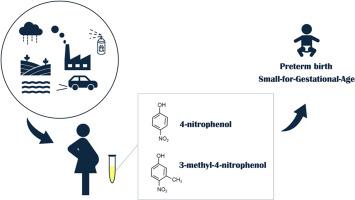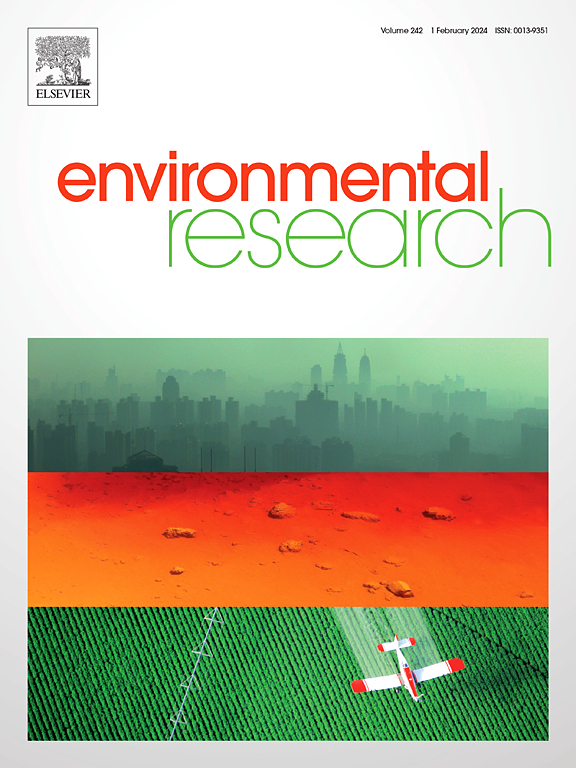母体尿中硝基苯酚浓度与不良出生结果和 4 岁时神经发育迟缓的关系:日本环境与儿童研究。
IF 7.7
2区 环境科学与生态学
Q1 ENVIRONMENTAL SCIENCES
引用次数: 0
摘要
据报道,母体尿液中的硝基苯酚浓度与早产和胎儿/后代发育迟缓有关,但目前尚无定论。我们研究了母体尿液中 4-硝基苯酚(4NP)和 3-甲基-4-硝基苯酚(3M4NP)浓度与不良出生结局以及后代神经发育迟缓之间的关系,根据后代性别分层,采用年龄与阶段问卷对后代 4 岁时的神经发育迟缓进行定义。日本环境与儿童研究(Japan Environment and Children's Study)共招募了 3650 名单胎非高血压母亲。高4NP(≥0.41 μg/L)和3M4NP(≥0.29 μg/L)被定义为≥最低浓度最低报告水平。利用这些二分的 4NP 和 3M4NP 浓度创建了四个组:均为低"、"均为高/低 "和 "均为高"。多变量逻辑回归模型用于估算调整后的几率比(aOR)和人群可归因分数(PAF)。就 4NP 和 3M4NP 而言,分别有 68.4% 和 19.0% 的参与者尿液浓度 "偏高"。与 "均低 "相比,总体分析表明 "均高 "与任何结果之间均无显著关联。然而,分层分析表明,"均高 "的 aOR(95% 置信区间 [CI])和 PAF(95% 置信区间)与早产 (本文章由计算机程序翻译,如有差异,请以英文原文为准。

Associations of maternal urinary nitrophenol concentrations with adverse birth outcomes and neurodevelopment delay at 4 years of age: The Japan environment and children's study
Maternal urinary nitrophenol concentrations are reportedly associated with preterm birth and foetal/offspring development delay, but the evidence is still inconclusive. We investigated the association between maternal urinary concentrations of 4-nitrophenol (4NP) and 3-methyl-4-nitrophenol (3M4NP) and adverse birth outcomes, as well as offspring neurodevelopment delay, defined using the Ages and Stages Questionnaires at 4 years of age, stratified by offspring sex. A total of 3650 non-hypertensive mothers with singleton births were enrolled from the Japan Environment and Children's Study. High 4NP (≥0.41 μg/L) and 3M4NP (≥0.29 μg/L) were defined as ≥ lowest concentration minimum reporting level. Four groups were created using these dichotomized 4NP and 3M4NP concentrations: ‘both low’, ‘either high/low’, and ‘both high’. Multivariable logistic regression models were used to estimate the adjusted odds ratios (aOR) and population attributable fraction (PAF). For 4NP and 3M4NP, 68.4% and 19.0% of participants had ’high’ urinary concentrations, respectively. Compared to ‘both low’, the overall analysis showed no significant associations between ‘both high’ and any of the outcomes. However, the stratified analysis showed that the aOR (95% confidence interval [CI]) and PAF (95% CI) for ‘both high’ regarding preterm birth (<37 weeks' gestation) were 2.7 (1.3, 5.7) and 16.3% (2.5%, 28.1%), respectively, in male offspring. Among female offspring, the aOR and PAF for the ‘both high’ regarding small-for-gestational-age (SGA)—defined as weight-for-gestational age <10 percentile based on the Japanese neonatal anthropometric charts—were 1.7 (1.0, 2.8) and 10.6% (−0.2%, 20.2%), respectively. Urinary 4NP and 3M4NP concentrations showed no association with low birth weight (<2500 g) and neurodevelopment delay.
In conclusion, offspring sex-specific associations of maternal urinary nitrophenols with preterm birth and SGA were observed. Even slight elevations in their levels may explain a certain proportion of preterm birth and SGA. The exposure source, expressed by urinary nitrophenols, should be identified.
求助全文
通过发布文献求助,成功后即可免费获取论文全文。
去求助
来源期刊

Environmental Research
环境科学-公共卫生、环境卫生与职业卫生
CiteScore
12.60
自引率
8.40%
发文量
2480
审稿时长
4.7 months
期刊介绍:
The Environmental Research journal presents a broad range of interdisciplinary research, focused on addressing worldwide environmental concerns and featuring innovative findings. Our publication strives to explore relevant anthropogenic issues across various environmental sectors, showcasing practical applications in real-life settings.
 求助内容:
求助内容: 应助结果提醒方式:
应助结果提醒方式:


